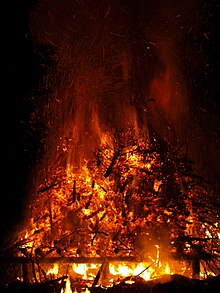Hutzelfire




The Hutzelfire is a regional variant of winter burning in central , eastern and northern Hesse and in Thuringia, with a focus on the Rhön . Common date is Hutzelsonntag , the first Sunday of Lent ( Invocabit ), but local variations may apply. In the Catholic region of Fulda , it has replaced the old custom of the St. John's fire and is sometimes also practiced in former Fulda exclaves in southern Hungary (southeastern Transdanubia ).
Until 1919 this tradition was forbidden by the church for a long time, because after the long winter and the carnival, further debauchery was feared during Lent . In Bischofsheim an der Rhön , “Torch Sunday” is celebrated on the 4th Sunday of Lent ( Laetare ). Some sources see the origin of the Hutzelfire as a spring fire in so-called Lätare customs (cf. also death carrying out ), others as an "extended" carnival custom .
Origin of the term
The term Hutzelfeuer is derived from the Hutzeln , a regional name for dried pears and plums, which were traditionally eaten on this day. Other sources report that so-called Hutzeln - along with crab and other additions - were given to the requesting children or boys who collected fuel such as straw for the fire.
In some places in the Rhön, even in the 21st century, schoolchildren who have already received communion, young people or boys dressed as "Hutzel witches" go from house to house and ask the residents to give them "Hutzeln" (also in pecuniary form) because otherwise they might hit the door with sticks or shout a mocking verse .
history
According to Otto Mahr, there is only evidence from the most recent times, although the customs contain elements that are rooted in pre-Christian times. The first testimonies are the bans on fire wheels from the years 1768–76 and 1786. In the literature, Hutzelsundag is only mentioned in the 19th century, the first significant account comes from Jäger in 1803 (MAHR 1938, 19; 1939, 11–11. 12, 39).
In the “ physics reports ” of the Weyhers and Hilders regional courts from 1861, it was described as a custom on Hutzelsunday that the young people preferred to pull up to the surrounding hills in the evening with about three meters long wooden poles with tufts of burning straw attached to the upper end where fresh seed fields were created, or around the boundary. Dried fruit and crops are also mentioned there.
present
Nowadays the Hutzelfire is kindled on a piled up brush pile, for which the Christmas trees no longer needed are collected in some places. The fire is supposed to drive away the winter symbolized by a Hutzel doll (also called Hutzelhexe or Hutzelmann ) placed on top . Today the Hutzelfire is mostly set up by clubs , for example youth fire brigades , sports clubs or other youth associations.
Since 2012 there has been an orientation paper for traditional fires in Hesse , which in part led to political controversy. The Hessian Ministry for the Environment, Energy, Agriculture and Consumer Protection made it clear in 2014 that the municipalities had requested such a manual and that the paper only offered assistance in order to “provide clarity for the cities and municipalities in the requirements for the display, implementation and protection of such called "traditional fires". "
See also
Web links
- Article by hr journalist Christoph Käppeler from March 2, 2001
Individual evidence
- ↑ Gottfried Rehm : Life in the Rhön - Contributions to Rhön History and Folklore Videel 2003, p. 64; see: Google Books
- ^ A b Katharina Wild: The Hutzelsundag in Southern Hungary (I) Hutzelsingen, Hutzellieder , contributions to the folklore of the Hungarian Germans on the website Sulinet.hu , accessed on February 19, 2018
- ^ Josef Dünninger, Horst Schopf: Die Plassenburg Volume 30, Friends of the Plassenburg p. 315; online in google books
- ^ Adolf Strack, Karl Helm, Hugo Hepding: Hessian sheets for folklore, volumes 39-41 W. Schmitz Verlag, 1941; P. 100; online in google books
- ^ Friedrich Kluge : Etymological dictionary of the German language ; Walter de Gruyter 1967 p. 323; online in google books
- ^ Fulda History Association : Publication of the Fulda History Association, Volume 49 ; Volume 17 of sources and treatises on the history of the abbey and the diocese of Fulda; P. 56, Parzeller 1971; online in google books
- ^ Deutsche Landschaft, Volume 1, Burkhard-Verlag 1956, p. 78; online in google books
- ↑ Home and History Association Silges (ed.): 700 years of Silges. A village through the ages. Nüsttal. District of Silges. 2000. pp. 135 f.
- ^ Mahr, Otto: On the history of Hutzelsundag. In: BuBl 1938, p. 19.
- ↑ Thomas Heiler , Klaus Reder, Willy Kiefer : The Hilders and Weyhers regional courts around 1860, Institute for German Philology, Würzburg, 2005, pages 93 and 153
- ↑ Orientation guide on the traditional fire of the Hessian Ministry for the Environment, Energy, Agriculture and Consumer Protection , accessed on February 21, 2018
- ↑ Hessen insists on orientation aid for traditional fire ( memento of the original of February 21, 2018 in the Internet Archive ) Info: The archive link has been inserted automatically and has not yet been checked. Please check the original and archive link according to the instructions and then remove this notice. , Frankfurter Neue Presse of March 7, 2014, accessed on February 21, 2018
- ↑ Customs fire , communication from the Hessian Ministry for the Environment, Climate Protection, Agriculture and Consumer Protection, accessed on February 21, 2018

